The crisis of 1943
In 1943, during the Second World War, Mexico was again faced with a silver crisis. A combination of reasons - anticipation of a rise in the price of silver; the Mexican government’s agreement to sell practically its entire silver production to the United States for its military industry; and a boom in the Mexican and US jewellery industries - caused the price of silver to rise and silver coins to be hoarded. On 21 August Mexico imposed a heavy export tax on silver products, to make it unprofitable to melt down silver coins to ship as bullion, and temporarily suspended a contract which promised all surplus silver production to the United States. However because of a shortage of fractional coinage, especially the fifty centavos denomination, it was compelled to authorise banks to issue cheques with printed denominations of twenty- five and fifty centavos. while it arranged for the production of new coins.
Torreón
Originally the Banco Mexicano Refaccionario offered to print 50c cheques for agricultural businesses so that they could make their payrollsEl Siglo de Torreón, 27 July 1943.
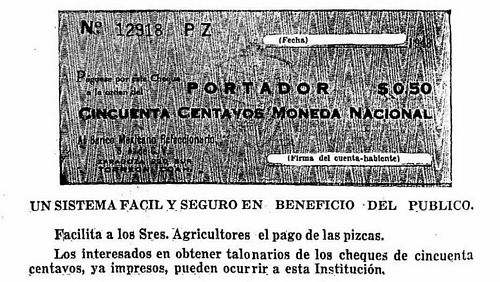
Then, on 5 August the Banco Mexicano Refaccionario agreed with the Cámara Nacional de Comercio and the Asociación Civil “Pequeña Propiedad Agrícola de la Comarca Lagunera” to issue 50c cheques, backed up by deposits left with the bank. A public notice was published the following day, giving details and the names of the signatories. The cheques would be available on 7 AugustEl Siglo de Torreón, 6 August 1943.
The cheques were well received and the bank had difficulty keeping up with demand from ranchers. ejidos and businessmen, the first two to pay wages and the last to carry out their businesses, because of the need to sign thousands and thousands of notesEl Siglo de Torreón, Año XXII, No. 1812, 8 August 1943; El Siglo de Torreón, 10 August 1943. San Pedro alone requested $6,500 in chequesEl Siglo de Torreón, 10 August 1943.
By 10 August the Cámara de Comercio decided to increase the number of signatories to ten Rodolfo Solís, Ricardo Ramírez, Mónico Esquivel, Juan José Martínez, Pánfilo Sánchez, Emigdio Ulloa, José Lozano, Santiago Villarreal, José S. Sada and Francisco Dingler, and the Pequeña Propiedad Agrícola might have done the same, as they were receiving request not only from Torreón, but from Gómez Palacio, Lerdo, Bermejillo, Tjahualilo, Matamoros, Francisco I. Madero y San Pedro. A single farmer from San Pedro, Manuel Antero Fernández, had asked for $6,000 in cheques. The two issuers also decided that any new printings would be on paper of better quality since until then, because of the time pressure and lack of adequate paper, the cheques were very thin and deteriorated easilyEl Siglo de Torreón, 11 August 1943.

These notes travelled because on 29 August it was reported in Monterrey, Nuevo León, that people were paying with cheques from casas comerciales in other cities, mainly from Torreón, and banks were taking them at a discountEl Porvenir, Monterrey, 30 August 1943.
The bank stopped issuing cheques in mid OctoberEl Siglo de Torreón, 17 October 1943.
Cámara Nacional de Comercio drawn on the Banco Mexicano Refaccionario, S. A. de C. V
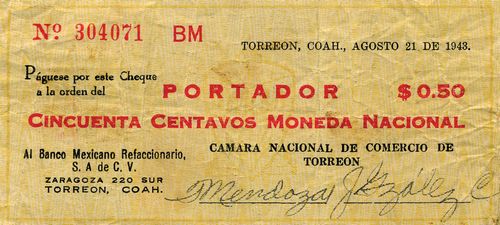
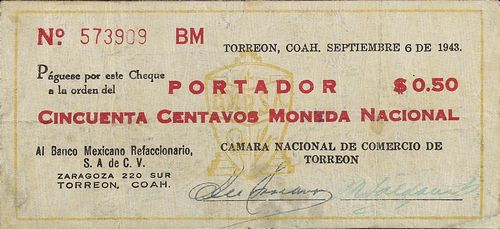
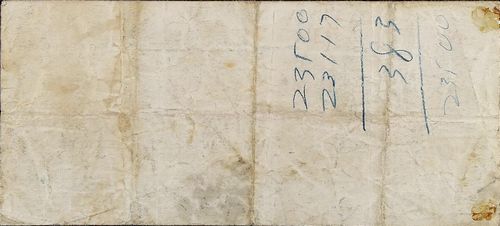 M4275 50c Cámara Nacional de Comercio
M4275 50c Cámara Nacional de Comercio
| Date on note | signature 1 | signature 2 | from | to | total value |
total number |
||
| 50c | 21 August 1943 | Mendoza | González | includes number 304071CNBanxico #10222 | ||||
| 6 September 1943 | includes number 573909 | |||||||
| 17 September 1943 | includes number 647196CNBanxico #123 |
The signatories included
| Nicolás Castañeda | 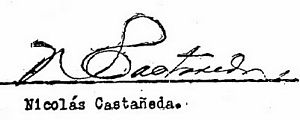 |
|
Luis Cavazos Hinojosa was born in Ciudad Porfrio Días (now Piedras Negras), Coahuila in 27 October 1902. He owned the Fábrica de Muebles de Refrigeración "Lucsa", that was the largest factory of its type in Mexico. He died in Torreón on 19 February 1995. |
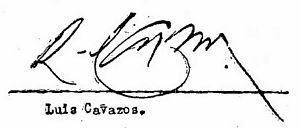 |
|
[if correct person] His company printed comprobantes de trabajo for the Haciendas Bilbao y Anexas in the 1930s. He was on the board of the Casino de la Laguna in 1946. He died on 24 May 1969. |
|
| Mónico Esquivel | |
|
|
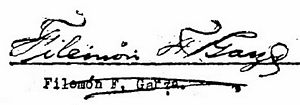 |
| Antonio P. González was on the board of the Casino de la Laguna in 1946. |  |
| J. González C. is not included in the public notices. |  |
| José Lozano | |
| Juan José Martínez | |
| [ ] Mendoza is not included in the public notices. |  |
| Ricardo Ramírez is listed in the local directory as owning a warehouse (Almacen de Depósito). | |
| Ambrosio Rodríguez | 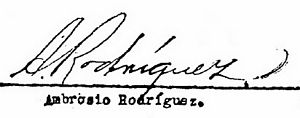 |
| José S. Sada Fernández was born in 1905 on the Hacienda de Ahualulco, San Luis Potosí and grew up in Monterrey, Nuevo León. He died on 27 July 1966. | |
| Jorge Samia | 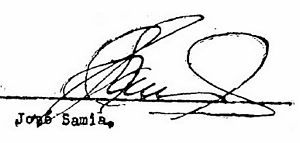 |
| Pánfilo Sánchez | |
| José A. Sepulveda |  |
| Rodolfo Solís Dávila | |
| Emigdio Ulloa | |
| Miguel Vázquez Ayala |  |
| Santiago Villarreal | |
| [ ]identification needed |  |
| [ ]identification needed |  |
Pequeña Propiedad Agrícola de la Comarca Lagunera, A. C., drawn on the Banco Mexicano Refaccionario, S. A. de C. V.
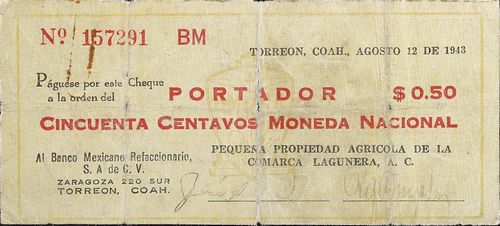
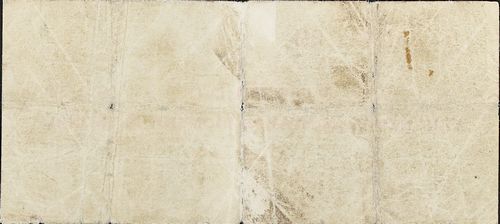
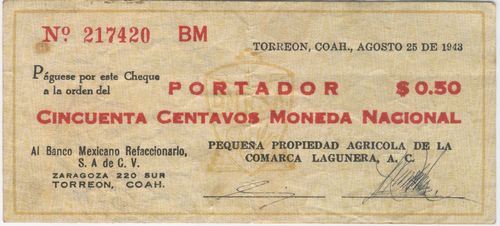 M4273 50c Pequeña Propiedad Agrícola
M4273 50c Pequeña Propiedad Agrícola
| Date on note | signature 1 | signature 2 | from | to | total number |
total value |
||
| 50c | 12 August 1943 | includes number 157291 | ||||||
| 25 August 1943 | de la Corda Rocha | includes number 217420 | ||||||
| 1 September 1943 | includes number 270281CNBanxico #10223 |
The signatories included
| Jesús de la Corda Rocha |  |
| Karmel L. de León | 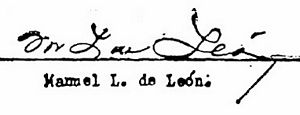 |
| Ernesto Franco Armendáriz is listed in the local directory as involved in agriculture. He was treasurer of the Casino de la Laguna in 1946, thus being the third treasurer, after Mauro de la Peña and Ezequiel Ramos Barrera, to sign local issues. |  |
| Jose A García is listed in the local directory as involved in agriculture. |  |
| Luis J. Garza was a well-known industrialist and farmer whose wine company, Cía. Vinicola del Vergel, S. A., was the most impotant in Mexico and one of the best in Latin America. |  |
| José Gonzales Calderon | 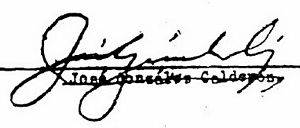 |
| Pedro Ibarra García | 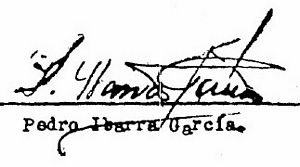 |
| Manuel Valencia | 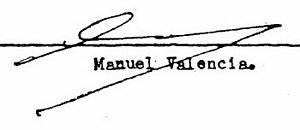 |
By early September the Banco Industrial y Agrícola, S. A. in Torreón had decided to accept $1 Banco de México notes cut in halfEl Siglo de Torreón,4 September 1943. This practice continued, though with ever greater reluctance, until late SeptemberEl Porvenir, Monterrey, Año XXV, Núm. 9679, 21 September 1943 but was prohibited by the Secretaría de Hacienda at the beginning of November El Siglo de Torreón, 2 November 1943.
Banco Industrial de Monterrey
In late September senator Joaquín Martínez Chavarría, who had just come from Torreón, told the Secretario de Hacienda that the Banco Industrial de Monterrey was circulating cheques for twenty and fifty centavosUniversal Grafico, Año XXII, Núm. 3,627, 24 September 1943.
Banco Fronterizo de México
In late September senator Joaquín Martínez Chavarría, who had just come from Torreón, told the Secretario de Hacienda that the Banco Fronterizo de México was circulating cheques for twenty and fifty centavosibid..
The Banco Fronterizo de México was organised in Piedras Negras, Coahuia, in [ ].

 Filemón F. Garza from Santa Rosa, Nuevo León, was presidente of the PRI in Torreón in 1933-1934 and was on the board of the Casino de la Laguna in 1946.
Filemón F. Garza from Santa Rosa, Nuevo León, was presidente of the PRI in Torreón in 1933-1934 and was on the board of the Casino de la Laguna in 1946.